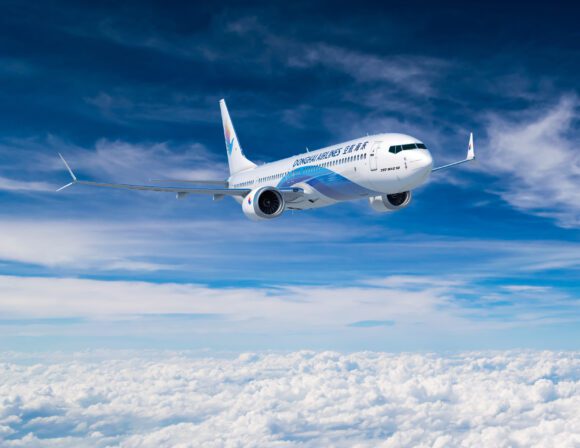
MAX8FF K66500 01 scaled
The first Boeing MAX 8s from Chinese airlines are expected to return to service before the end of the year. But this depends entirely on how quickly the grounded aircraft will be modified and cockpit crew trained for the revised procedures. Still, Boeing can breathe a sigh of relief that the Civil Aviation Administration of China (CAAC) has cleared the MAX for the return to service. China’s recertification reopens key market for Boeing MAX.
The CAAC was the first regulatory agency in the world the summon the grounding of the MAX in March 2019, immediately after the crash of the Ethiopian Airlines aircraft. This was the second crash of a MAX 8 in less than five months. The subsequent investigations into the cause of both accidents revealed that the MAX has a system, the Maneuvering Augmentation Characteristics System (MCAS), that automatically compensates for pitch-up maneuvers induced by the more powerful CFM LEAP-1B engines. The real characteristics of MCAS were known to only a few pilots but not to the crew of the fatal flights of Lion Air and Ethiopian.
The accident investigations, media, and Congressional committee revealed later that Boeing had tried to hide the characteristics of MCAS from the FAA and airlines, mainly to prevent pilots from being required to take lengthy training before they could fly the MAX. The MAX was recertified by the FAA in November 2020 and in January by EASA and other regulators, but only after Boeing modified the MCAS system to make it more redundant (two angle of attack sensors instead of just a single one) and revised pilot training.
While the MAX has been flying since December 2020 again in most countries, China refused to clear the type for re-entry into service. Officially because the CAAC wanted to see for themselves if the aircraft was safe, but unofficially because the MAX issue had become one of the focal points in the trade war and tense relations between Washington and Beijing. The first signal that China was willing to discuss the MAX issue again came in July. Soon after that, Boeing sent its MAX 7 prototype to Shanghai to demonstrate its airworthiness to the CAAC. Interestingly, this included only a single flight off-coast of Shanghai before the aircraft flew back to Seattle. Since then, Boeing officials frequently said that they hoped the recertification of the MAX would happen “within weeks” or “soon”, like Ihssane Mounir said in a pre-Dubai Airshow briefing.
AD includes number of modifications
The CAAC said in November that it was prepared to approve the MAX and confirmed this on December 1, when it issued an Airworthiness Directive (AD). In line with what other regulatory agencies have said, the Chinese authorities request a number of changes before the MAX can enter service. This includes the update of both flight control computers operating program software, the display system software, the fitting of a second angle of attack sensor, installation of a stall warning stick shaker jump switch button with color cap, plus the revision of the minimum equipment list (MEL) and flight manuals. Also required is a change to the wiring to the horizontal stabilizers, after the accident investigation revealed that wiring was too close together.
Air China took delivery of its first MAX 8 in November 2017. (Boeing)
Although airlines can request special permission for charter flights to ferry stored MAX aircraft, an aircraft can only return to service after checks and a demonstration flight, says the AD, which has become effective on December 2. This means that MAX operators like China Southern Airlines, Xiamen Airlines, Air China, Okay Airways, China Eastern, Hainan Airlines, and many subsidiaries can now start modifying their 94 aircraft, which have been in storage for 21 months.
And then there are the undelivered aircraft. During its Q3 results presentation in October, Boeing said that roughly one-third of the 370 it had in inventory back then were for Chinese customers. Delivering them will mean a huge boost for Boeing’s cash flow, which should return positive in 2022 thanks to higher MAX and 787 deliveries.
Boeing’s official backlog of MAX for Chinese customers as of today includes 104 aircraft: 36 for Ruili Airlines, 34 for China Southern, 25 for Donghai Airlines, and nine for Okay Airways. But these exclude orders from lessors with Chinese connections like BOC Aviation (45), CALC (66), CDB Aviation (21), and likely others among the undisclosed customers for 685 MAX of different versions.
Donghai Airlines ordered ten MAX 10 at the 2017 Paris Airshow. (Boeing)
CEO David Calhoun has stressed on many occasions the importance of the Chinese market, which should require 6.500 single-aisle aircraft until 2040. The production rate of the MAX depends on the reopening of China, said Calhoun. The current plan is to ramp up production to 31 aircraft per month in 2022, but this could go higher if the reopening of China translates into new orders.
During its Capital Markets Day on December 2, engine maker Safran said it expects Boeing to produce fifty MAX per month by the end of 2023. Tier 1-supplier Spirit AeroSystems, which produces the fuselages for the MAX, said in November that it expects to deliver 275 to 300 737 shipsets to Boeing next year, “but it depends on what Boeing is up to after the first quarter”, said CEO Thomas Gentile. Spirit is ready to ramp up if that’s required.
As China’s recertification reopens key market for Boeing MAX, Russia now remains one of the last countries still to block the return to service of the MAX. UTAir is the only airline listed in Boeing’s backlog to receive the type, with 28 on order.
Views: 0





